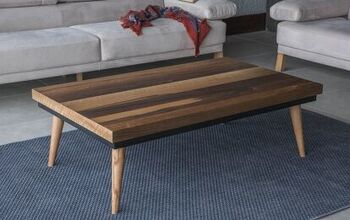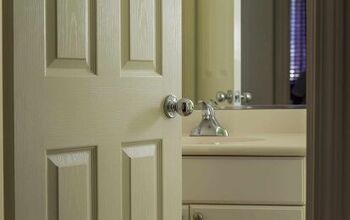Does A Laundry Room Need A Door?

Laundry rooms are as necessary as they are complicated and sometimes high-maintenance. They can be messy, cluttered, and quite loud during operation which is enough to annoy any homeowner. That alone has made many homeowners ask; does a laundry room need a door?
Building codes don’t require a door for a laundry room, but it is a great idea to install one. A laundry room door can significantly reduce the noise that your washer and dryer produce during operation. You can also reduce the risk of a fire as well as mold and mildew damage with a vented laundry room door.
Vented doors are the best option for a laundry room because they help disseminate the heat and moisture. This can minimize the chance of mold growth, but vented doors don’t reduce noise as well. Follow along as we explore why a laundry room doesn’t need a door, but why it’s still a great idea.
Laundry Room Door Requirements
You are not required to put a door in your laundry room by building codes, but it is useful. Washing machines and dryers produce plenty of noise while they operate, and doors can help minimize it. Installing a door can also let you keep others from seeing the contents of your laundry room when it is messy.
While building codes don’t have specific door requirements, not all doors are ideal for a laundry room. A standard door can certainly reduce the noise of a washer and dryer, but it is not ideal for ventilation. Vented doors are the best option for a laundry room because they improve ventilation and make the space less stuffy.
One of the main reasons to install a vented door in your laundry room is to reduce the risk of fire. This isn’t required by building codes, but the extra ventilation can improve the safety of your home. Standard doors that aren’t vented are also common in laundry rooms, but they aren’t as safe.
Vented Laundry Room Door
Vented laundry room doors may not filter out all of the noise, but that is their only downside. The added ventilation improves the airflow in your laundry room. Vented doors generally feature slats that minimize the noise without obstructing the airflow.
Anything that you can do to improve the ventilation in your laundry room can help prevent a mess. Dust and lint can accumulate and settle more easily without ventilation. Vented laundry room doors can also help reduce the risk of mold and mildew that is common in laundry rooms.
You can also find doors with vents that are at the top instead of slats throughout the whole door. This is a better option if you want to reduce more noise. However, the ventilation may not be as effective as a louver because having more slats improves airflow.
Laundry Closet Doors
Laundry closets are a great way to conserve space so that you can use the rest of the room for utility purposes. However, homeowners install laundry closets in several areas of the house as long as there is a proper setup and connection. Doors are just as important for a laundry closet as they are for a traditional laundry room.
Much like a standard laundry room, vented doors are the best option for a laundry closet. They are perhaps even more important for a laundry closet than a room because of the confined space. Mold and mildew have a strong chance of growing in a laundry closet because they feature prime mold conditions.
The moisture, darkness, and warmth of a laundry closet are risky for mold and mildew, especially during operation. Install a louvered door for your laundry closet to let some of the moisture escape so that mold won’t be a problem.
Laundry Room Doors Ideas
There are only a few basic types of laundry room doors, such as sliding and bifold doors. The best option for you depends on your taste, budget, and how much space you have. Another important factor is whether you need a door for a laundry room or simply a laundry closet.
Sliding
Sliding laundry room doors are great for privacy as well as ventilation. You can improve the airflow in your laundry room if you don’t pull your sliding door completely shut. This allows you to dull the sound of the washer and dryer without restricting airflow to the room.
Sliding doors are also stylish, lightweight, and low maintenance because they don’t have hinges. You can install sliding doors for a laundry closet or for the laundry room itself. However, sliding doors are only ideal for a laundry closet if it is big because of how they overlap.
Bifold
Every laundry room can benefit from bifold doors, particularly if your washer and dryer are in a closet. Bifold doors are convenient because you can open them without covering up one of the machines. Conversely, a sliding door only allows you to access one machine or another because one is always covered.
That is not an issue with bifold doors which makes it easier to load and unload your laundry. Vented bifold doors are the best option because they can reduce the risk of mold and mildew. Bifold doors are just as stylish when vented, but they won’t muffle the noise as well.
Barn Door
You won’t find a barn door in front of a laundry closet, but they are great for laundry room entry. Sliding barn doors are more popular than ever, and they are a perfect fit for laundry rooms. There are even sliding barn doors with a top panel that you can remove or retract to help ventilate the space.
Both wood and glass panel barn doors can complement a laundry room and add a sense of style. However, glass panel barn doors are the best option if you have a modern aesthetic and want a removable panel for ventilation.
Does a Laundry Room Need a Window?
A laundry room doesn’t need a window according to building codes. However, you can improve the ventilation and airflow in your laundry room if there is a window. Laundry rooms tend to feel cramped, and a window can help get rid of that vibe.
The addition of a window won’t make the room larger, but it will make it feel more open. Natural light can open up an area and make it more pleasant to do the laundry. However, laundry rooms don’t require a window because they don’t count as habitable spaces.
Bedrooms and kitchens are considered habitable spaces because they are necessary for comfortable living. That cannot be said about laundry rooms, even if they are a modern commodity for all homeowners.
Summing It Up
A laundry room doesn’t need a door, but it is a great idea to install one. The door can help dull some of the noise that the washer and dryer create which is infinitely useful. However, it isn’t a great idea to install a standard solid door without ventilation for a laundry room.
Solid doors without a vent or slats won’t reduce the risk of mold and mildew like a vented door can. Vented doors can reduce the risk of fire as well as mold damage whether it is for a laundry closet or the room itself. A laundry room door is also a great way to get some more privacy and cover-up clutter in your laundry room.
Bifold doors are the best option if you have a laundry room closet, especially if the doors are vented. Otherwise, consider a sliding barn door with a removable top or bottom panel to add more ventilation. Consider a door for your laundry room or laundry closet to get more privacy and reduce noise.
Related Guides

Nick Durante is a professional writer with a primary focus on home improvement. When he is not writing about home improvement or taking on projects around the house, he likes to read and create art. He is always looking towards the newest trends in home improvement.
More by Nick Durante















![Cost To Drill A Well [Pricing Per Foot & Cost By State]](https://cdn-fastly.upgradedhome.com/media/2023/07/31/9074980/cost-to-drill-a-well-pricing-per-foot-cost-by-state.jpg?size=350x220)











